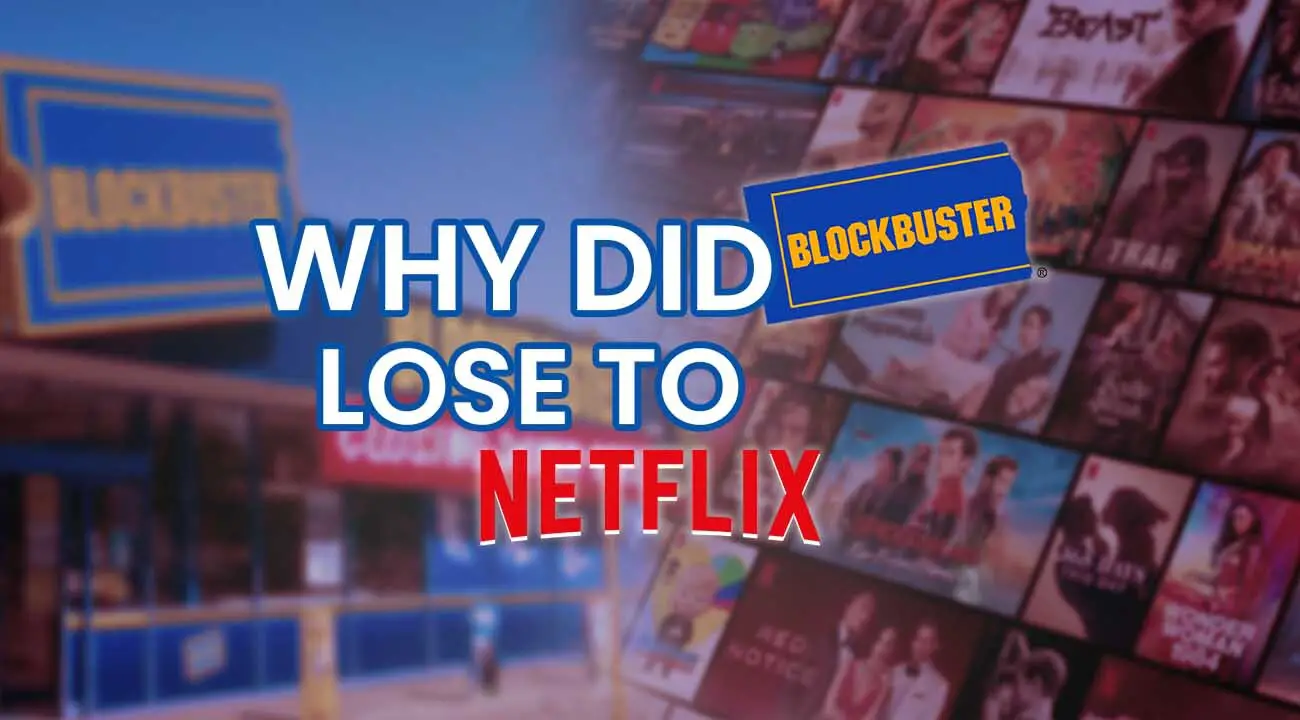Table of Contents
Among the new age generation, terms like “Netflix & Chilling” or “Binging” has become quite popular, and Netflix is the reason behind this. But, apart from Netflix, other OTT platforms like Amazon Prime, Apple TV+, Disney+, and HBO Max have also taken over a large part of global entertainment at household, which was once dominated by the video rental giant – Blockbuster. Generally, video rental refers to renting movies, pre-recorded TV shows, VHS tapes, and DVDs to customers.
Within a decade of its inception, Blockbuster had more than 65 million registered customers worldwide, with more than 9,000 stores employing 84,000 employees. However, in the late 2000s, Blockbuster lost popularity as viewers moved to the popular on-demand video streaming platform – Netflix instead of DVD rentals. But is Netflix solely responsible for the fall of Blockbuster?
Overview
In 1985, David Cook, a software supplier to the oil and gas industry, realized that the video rental business could revolutionize the industry if managed efficiently. At the time, video rental stores could track 100 or more tapes. David Cook developed an innovative barcode system to solve this problem. Each store could track 10,000 VHS for each registered customer through this bar code system. Based on this unique bar code system, David Cook and his wife Sandy Cook started Blockbuster Video in 1985 under the name “Blockbuster Video Inc.”.
In 1985, they established Blockbuster’s first store in Dallas, Texas, with an inventory of 8,000 VHS and 2,000 beta tapes. Blockbuster’s blue-yellow logo was designed by Cook’s wife, Sandy Cook, which became an attraction point for customers in the neighborhood. However, the barcode system developed from Cook’s database management experience was the most significant contributor to Blockbuster’s business, and the company became popular within a few months of its launch. After the first store’s success, Cook spent $6 million to establish a warehouse in Garland, Texas, to support the ever-increasing number of Blockbuster stores.
In 1987, David Cook raised a total investment of $18.5 million from Wayne Huizenga, John Melk, and Ray Kroc. Thanks to Ray Kroc’s expansion model and Huizenga and Melk’s waste management business technique, Blockbuster’s stores continued to expand rapidly and opened at least one store per day.
However, later that year, when Blockbuster’s headquarters were moved to Fort Lauderdale, Florida, founder David Cook left Blockbuster. Moreover, the company won a lawsuit with Nintendo and started video game rental the same year. Under Huizenga’s hand, in 1988 Nationwide became America’s No. 1 video chain with around 600 (593) stores. Later, in the early 1990s, Blockbuster added music video rentals to their stores, making it a multi-billion dollar company.
Despite becoming a multi-billion dollar company, the growth of new technologies such as cable television and video-on-demand became a severe concern to Huizenga’s Blockbuster. In fact, when Time Warner announced an upgrade to its cable system in 1991, Blockbuster’s shares dropped 10 percent. Huizenga also plans to build a Blockbuster sports & amusement park in Florida. However, it was a completely different sector, and the risk of the video business was constantly increasing.
Following this, Blockbuster announced its merger with American media conglomerate Viacom in 1994, and Wayne Huizenga left the company after the merger. At the time, Blockbuster was worth $8.4 billion and was wholly owned by Viacom. After the merger with Viacom was completed, Blockbuster Video was renamed simply Blockbuster. Also, a slight change was made in the logo, and Taco Bell’s former president, John Antioco, was appointed CEO of the Company.

Reason Behind The Fall
Failure To Adopt New Technology
Blockbuster used to offer VHS tape rentals to customers. VCR and Betamax technology originally superseded VHS tape as the standard videotape format. But as technology improved and DVD became popular in the late 1990s, production and distribution companies quickly adopted DVD. In 1998, Warner Brothers offered Blockbuster CEO Antioco an exclusive rental deal, but Antioco rejected the offer and decided to continue with VHS video rentals.
After Blockbuster’s rejection, Warner Brothers started offering DVDs as a retail product at lower prices. Walmart also saw this as an ample opportunity and began selling DVDs at a loss in their stores. For Walmart, DVD was a loss leader that could attract customers to purchase more expensive items such as DVD players, TVs, etc.
Failure To Identify Competitors
In 1998, An online DVD rental service launched a website named Netflix. Blockbuster used to charge a late fee to their customers if they were unable to return the VHS tape on time. Reed Hasting was so frustrated about this late fee, so he and Marc Randolph built Netflix together. The primary idea of Netflix was to allow customers to select movies according to their choice and then deliver the cinema via email.
At that time, both Netflix founders were confused about whether they should pick VHS tape or DVD. But, since Walmart was doing pretty well with DVD selling, Reed and Marc decided to adopt new DVD technology instead of VHS tape. Customers really liked the idea of receiving a movie by mail rather than going to a store to rent a movie.
The DVD market was very small at that period, so Blockbuster wasn’t giving much attention to Netflix. In 1999, Viacom added Blockbuster as a publicly listed company by launching an IPO on New York Stock Exchange. On the other hand, Best buy and other retailers also started to follow Walmart’s path of selling DVDs at a loss which caused the Dotcom Bubble Crush, and due to this, Netflix was having problems running its business.
Then, Reed Hastings offered Netflix to Blockbuster owners in return for $50 Million, but the Blockbuster management rejected it. As a result, Netflix changed its business model and introduced monthly subscriptions. At that time, the company was offering unlimited movie rentals for $19.95 to customers for a maximum of 3 months at a time, which was very popular among customers. At the end of that year, Blockbuster’s revenue rose 14.6 percent to $4.46 billion over the previous year.


While Netflix was trying to survive with a subscription model in 2000, Blockbuster teamed up with Enron in the middle of that year to create an online video-on-demand service. Big companies like Enron worked behind the creation of the service, but online streaming was not possible at that time due to the slow speed of dial-up Internet.
Meanwhile, due to the Enron Scandal in 2001, Blockbuster no longer worked on this video-on-demand project. Meanwhile, Netflix launched its IPO in May 2002 as its subscriber, and revenue growth continued in 2001 after surviving the Dotcom bubble crash. Meanwhile, following Netflix’s success, Blockbuster bought Arizona-based online DVD-rental company “DVD Rental Central” with 10,000 subscribers for just $1 million in 2002.
In 2004, the company was rebranded as Blockbuster Online and launched as a subscription service. In addition, the company removed its Late Fee that year. Although Netflix had already taken over the online DVD rental service market, Blockbuster’s revenue was still $5.9 billion that year.
| Blockbuster (Mn USD) | ||
| Year | Sales | Net Income/(Loss) |
| 2000 | 4960 | (76) |
| 2001 | 5157 | (240) |
| 2002 | 5566 | (1621) |
| 2003 | 5912 | (979) |
| 2004 | 5933 | (1248) |
| 2005 | 5722 | (584) |
| 2006 | 5522 | 51 |
| 2007 | 5314 | (74) |
Rise Of Online Streaming
In 2007, Blockbuster launched a new “Total Access” campaign to stop this decline. Under this campaign, Blockbuster allows customers to rent DVDs online and offers a new movie for free when they return it to a Blockbuster store. This campaign worked well, and Blockbuster’s profits increased again. With this, Reed Hastings offered Antioco to buy Blockbuster Online when Netflix began to feel threatened.
Netflix originally wanted the service to allow customers to rent movies online from Netflix and deposit them at Blockbuster stores, which would be convenient for Netflix customers and increase foot traffic at Blockbuster stores. This time Antioco agreed to Hastings’ offer, but days before the deal closed, Antioco resigned from Blockbuster, and James Keyes took over the company. Keyes rejects Hastings’ proposal and even closes the free movie deal. Apart from this, the subscription price of an online DVD rental is also increased.
Meanwhile, in 2007, Netflix started offering online movie streaming services. Although before Netflix, in 2006, Amazon began to offer a video streaming service called Unbox. In addition, in 2007, Walt Disney and NBCUniversal launched another streaming service called Hulu.
Meanwhile, in August 2007, Blockbuster acquired Internet movie provider Movielink to provide video download services to customers. But the company wasn’t entirely focused on streaming like Netflix, rather, it continued with rental services. In the expansion of rental services, the company acquired ChoicesUK in the UK and rebranded 59 of the company’s stores as Blockbuster stores.
Also, in 2008, Blockbuster unsuccessfully attempted to acquire USA’s consumer electronics retailer Circuit City. Since 2009, Blockbuster’s store count has been declining, reaching 6,500, 4,000 of which were in the United States by the beginning of 2010. That year the company further reduced the number of stores in the USA and installed more than 10,000 DVD rental kiosks, “Blockbuster Express” across the US. But despite all these, the company could not keep up with the popularity of online streaming platforms.
As a result, Blockbuster filed for bankruptcy in 2010 with $900 million in debt. When Blockbuster was sold to Dish Network for $320 million, the new management announced a new service called Blockbuster Movie Pass to compete with Netflix. Under this service, customers get simultaneous streaming and video access through the mail service for a monthly subscription of $10.
However, as Blockbuster’s franchisees began closing physical stores one by one, it became impossible for Dish Network to continue its video-on-demand service by mail. However, the company was still working out how to continue streaming and video-on-demand services with running stores. But, as stores are constantly closing, Blockbuster currently has only one store left in the entire United States, in Bend, Oregon. Also, the online service has only one homepage, which basically redirects to Dish Network’s website.










Leave a Comment